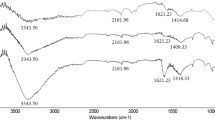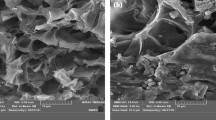Abstract
The adsorption of hexamine onto powdered activated carbon from aqueous solutions was studied in a fixed bed system. Langmuir, Freundlich, Redlich–Peterson and Toth isotherm models were used to fit the experimental data and isotherm parameters were determined. The results revealed that the adsorption isotherm models fitted the data in the order of Langmuir > Toth > Redlich–Peterson > Freundlich. Lagergren pseudo-first order kinetic model was found to correlate well with the experimental data. The effects of solution pH, temperature, initial hexamine concentration and added salts concentration on the adsorption capacity and the rate of adsorption were studied. The results indicate that the rate of adsorption increases and then decreases as temperature of the hexamine solution increases, however, the adsorption capacity decreases. The addition of low concentration of salt significantly increases the adsorption capacity of activated carbon. The results showed that the activated carbon has potential for the adsorption of hexamine from industrial hexamine wastewater.







Similar content being viewed by others
References
Alamdari A, Tabkhi F (2004) Kinetics of hexamine crystallization in industrial scale. Chem Eng Process 43(7):803–810
Annadurai G, Juang RS, Lee DJ (2002) Use of cellulose-based wastes for adsorption of dyes from aqueous solutions. J Hazard Mater 92(3):263–274
Arafat HA, Franz M, Pinto NG (1999) Effect of salt on the mechanism of adsorption of aromatics on activated carbon. Langmuir 15(18):5997–6003
Balasubramanian M, Thennarasu S, Sudhakaran T, Perumal PT (2003) Spectrophotometric and fluorimetric determination of hexamine in pure form and its pharmaceutical formulation. Biol Pharm Bull 26(8):1211–1214
Bansal RC, Goyal M (2005) Activated carbon adsorption. Taylor and Francis Group, London, pp 351–353
Behera SK, Kim JH, Guo X, Park HS (2008) Adsorption equilibrium and kinetics of polyvinyl alcohol from aqueous solution on powdered activated carbon. J Hazard Mater 153(3):1207–1214
Behera SK, Oh SY, Park HS (2012) Sorptive removal of ibuprofen from water using selected soil minerals and activated carbon. Int J Environ Sci Technol 9:85–94
Boehm H (1994) Some aspects of the surface chemistry of carbon blacks and other carbons. Carbon 32(5):759–769
Cabal B, Ania C, Parra J, Pis J (2009) Kinetics of naphthalene adsorption on an activated carbon: comparison between aqueous and organic media. Chemosphere 76(4):433–438
Cooney DO, Wijaya J (1987) Effect of pH and added salts on the adsorption of ionizable organic species onto activated carbon from aqueous solution. In: Proc. 2nd Eng. Found. Conf. Fundam. Adsorpt, pp 185–194
El-Sayed Y, Bandosz TJ (2003) Effect of increased basicity of activated carbon surface on valeric acid adsorption from aqueous solution activated carbon. Phys Chem Chem Phys 5(21):4892–4898
Freundlich H (1906) ber die adsorption in läsungen. Z Phys Chem 57:385–470
Gur-Reznik S, Katz I, Dosoretz CG (2008) Removal of dissolved organic matter by granular-activated carbon adsorption as a pretreatment to reverse osmosis of membrane bioreactor effluents. Water Res 42(6–7):1595–1605
Ho YS, Porter JF, McKay G (2002) Equilibrium isotherm studies for the sorption of divalent metal ions onto peat: copper, nickel and lead single component systems. Water Air Soil Pollut 141:1–33
Hutnan M, Drtil M, Derco J, Mrafkova L (2005) Biodegradation of hexamethylenetetramine in anaerobic baffled reactor. Pol J Environ Stud 14(5):585–591
Kaszycki P, Koloczek H (2002) Biodegradation of formaldehyde and its derivatives in industrial wastewater with methylotrophic yeast Hansenula polymorpha and with yeast-augmented activated sludge. Biodegradation 13(2):91–99
Langmuir I (1916) The constitution and fundamental properties of solids and liquids. Part I. Solids. J Am Chem Soc 38(11):2221–2295
McDonough KM, Fairey JL, Lowry GV (2008) Adsorption of polychlorinated biphenyls to activated carbon: equilibrium isotherms and a preliminary assessment of the effect of dissolved organic matter and biofilm loadings. Water Res 42(3):575–584
Mckay G, Blair H, Gardner J (1982) Adsorption of dyes on chitin. I. Equilibrium studies. J Appl Polymer Sci 27(8):3043–3057
Middelhoven WJ, van Doesburg W (2007) Utilization of hexamethylenetetramine (urotropine) by bacteria and yeasts. Antonie Leeuwenhoek 91(2):191–196
Ncibi MC, Mahjoub B, Seffen M (2007) Adsorptive removal of textile reactive dye using Posidonia oceanica (L.) fibrous biomass. Int J Environ Sci Tech 4(4):433–440
Onundi YB, Mamun AA, Al Khatib MF, Ahmed YM (2010) Adsorption of copper, nickel and lead ions from synthetic semiconductor industrial wastewater by palm shell activated carbon. Int J Environ Sci Technol 7(4):751–758
Ozacar M (2003) Phosphate adsorption characteristics of alunite to be used as a cement additive. Cem Concr Res 33:1583–1587
Rafati L, Mahvi AH, Asgari AR, Hosseini SS (2010) Removal of chromium (VI) from aqueous solutions using Lewatit FO36 nano ion exchange resin. Int J Environ Sci Technol 7(1):147–156
Redlich O, Peterson DL (1959) A useful adsorption isotherm. J Phys Chem 63(6):1024–1024
Saadatjou N, Taghdiri M, Farrokhi R (2010) Removal of urotropine from industrial wastewater by acidic cation exchange resins. Iran J Environ Health Sci Eng 7(4):345–352
Seidel A, Radeke KH (1990) Effect of pH on adsorption equilibria for dissolved weak organic electrolytes on activated carbon. Acta Hydrochim Hydrobiol 18(6):691–699
Strom JG, Jun HW (1986) Separation and quantitation of methenamine in urine by ion-pair extraction. J Pharma Sci 75(4):416–420
Sun G, Xu X (1997) Sunflower stalks as adsorbents for color removal from textile wastewater. Ind Eng Chem Res 36:808–812
Tanada S, Boki K, Ohtani N, Yamasaki R (1985) Steric effect in the adsorption of ammonia and trimethylamine into micropores of activated carbon. Chem Pharm Bull 33(2):837–841
Tanada S, Tsutusi S, Boki K, Nakamura T (1988) Adsorption behavior of ammonia and trimethylamine binary mixtures in pores of plasma-treated activated carbon. Eisei Kagaku 34(2):156–160
Ting WP, Huang YH, Lu MC (2007) Catalytic treatment of petrochemical wastewater by electroassisted fenton technologies. React Kinet Catal Lett 92(1):41–48
Tsutomu I, Takashi A, Kuniaki K, Kikuo O (2004) Comparison of removal efficiencies for ammonia and amine gases between woody charcoal and activated carbon. J Health Sci 50(2):148–153
Yapsakl K, Çeçen F, Akta Ö, Can ZS (2009) Impact of surface properties of granular activated carbon and preozonation on adsorption and desorption of natural organic matter. Environ Eng Sci 26(3):489–500
Yu Z, Peldszus S, Huck PM (2009) Adsorption of selected pharmaceuticals and an endocrine disrupting compound by granular activated carbon. 1. Adsorption capacity and kinetics. Environ Sci Tech 43(5):1467–1473
Acknowledgments
The authors express their appreciation to Sina Chemical Industries Company and Payame Noor University for support of this study.
Author information
Authors and Affiliations
Corresponding author
Rights and permissions
About this article
Cite this article
Taghdiri, M., Zamani, N. Hexamine adsorption study on activated carbon from aqueous solutions for application in treatment of hexamine industrial wastewater. Int. J. Environ. Sci. Technol. 10, 19–26 (2013). https://doi.org/10.1007/s13762-012-0102-2
Received:
Revised:
Accepted:
Published:
Issue Date:
DOI: https://doi.org/10.1007/s13762-012-0102-2




